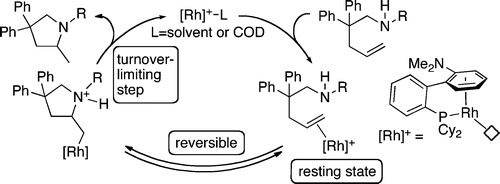Rhodium Phosphine-π-Arene Intermediates in the Hydroamination of Alkenes

A detailed mechanistic study of the intramolecular hydroamination of alkenes with amines catalyzed by rhodium complexes of a biaryldialkylphosphine is reported. The active catalyst is shown to contain the phosphine ligand bound in a κ1, η6 form in which the arene is π-bound to rhodium. Addition of deuterated amine to an internal olefin showed that the reaction occurs by trans addition of the N−H bond across the C═C bond, and this stereochemistry implies that the reaction occurs by nucleophilic attack of the amine on a coordinated alkene. Indeed, the cationic rhodium fragment binds the alkene over the secondary amine, and the olefin complex was shown to be the catalyst resting state. The reaction was zero-order in substrate, when the concentration of olefin was high, and a primary isotope effect was observed. The primary isotope effect, in combination with the observation of the alkene complex as the resting state, implies that nucleophilic attack of the amine on the alkene is reversible and is followed by turnover-limiting protonation. This mechanism constitutes an unusual pathway for rhodium-catalyzed additions to alkenes and is more closely related to the mechanism for palladium-catalyzed addition of amide N−H bonds to alkenes.
Read more on publisher's site.